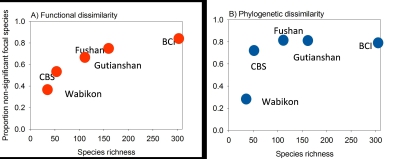Ecology:中科院沈阳生态所王绪高研究组发表森林木本植物多样性
近日,国际期刊《Ecology》在线发表了中国科学院沈阳应用生态研究所天然林生态组王绪高及其合作者的一篇研究论文。
生物多样性维持机制是生态学研究的热点问题之一,但一直存在很大争议。如传统的起源于物种较少地区的生态位理论,强调种间关系和环境异质性等确定性过程对于维持生物多样性的作用,然而由于其不能很好地解释物种丰富地区的生物多样性分布格局,近年来受到来自强调随机过程等中性理论的挑战。中性理论假设物种等同,即物种之间没有显著的种间关系。然而许多研究表明无论在温带森林还是在热带雨林,种间关系都显著影响植物的生长和存活,这似乎与中性理论的假设不一致。
针对这一问题,中国科学院沈阳应用生态研究所天然林生态组王绪高及其合作者提出了随机稀释假说,即由于各物种间的关系不一致,随着森林内物种数的增加,目标种与其领域其他物种的关系随之稀释,这就造成了在物种较少的温带森林,呈显著种间关系的物种对所占的比例,要高于物种丰富的热带森林。为了验证该假说,他们基于5个面积>20ha森林样地的数据(树种数分别是36(WABIkon温带)、52(CBS温带)、110(Fushan亚热带)、159(Gutianshan亚热带)和 304(BCI热带)),利用了多变量点格局分析方法,考虑各树种间的亲缘关系和功能相似性,将树种分为促进种(增加领域树种多样性)、抑制种(降低领域树种多样性)和中性种(没有显著影响),探讨各类型多占比例沿物种数的变化趋势。基于随机稀释假说,中性树种所占的比例应随着树种数的增加而增加,研究结果与该假说的预测一致,验证了该假说。
该结果验证了中性理论关于物种之间没有显著种间关系的假设在热带雨林的合理性,但不适应于温带森林,丰富发展了森林生物多样性维持机制理论。

中性物种所占的比例随物种数的变化趋势
原文链接:
Stochastic dilution effects weaken deterministic effects of niche-based processes in species rich forests
原文摘要:
Recent theory predicts that stochastic dilution effects may result in species-rich communities with statistically independent species spatial distributions, even if the underlying ecological processes structuring the community are driven by deterministic niche differences. Stochastic dilution is a consequence of the stochastic geometry of biodiversity where the identities of the nearest neighbors of individuals of a given species are largely unpredictable. Under such circumstances, the outcome of deterministic species interactions may vary greatly among individuals of a given species. Consequently, nonrandom patterns in the biotic neighborhoods of species, which might be expected from coexistence or community assembly theory (e.g., individuals of a given species are neighbored by phylogenetically similar species), are weakened or do not emerge, resulting in statistical independence of species spatial distributions. We used data on phylogenetic and functional similarity of tree species in five large forest dynamics plots located across a gradient of species richness to test predictions of the stochastic dilution hypothesis. To quantify the biotic neighborhood of a focal species we used the mean phylogenetic (or functional) dissimilarity of the individuals of the focal species to all species within a local neighborhood. We then compared the biotic neighborhood of species to predictions from stochastic null models to test if a focal species was surrounded by more or less similar species than expected by chance. The proportions of focal species that showed spatial independence with respect to their biotic neighborhoods increased with total species richness. Locally dominant, high-abundance species were more likely to be surrounded by species that were statistically more similar or more dissimilar than expected by chance. Our results suggest that stochasticity may play a stronger role in shaping the spatial structure of species rich tropical forest communities than it does in species poorer forests. These findings represent an important step towards understanding the factors that govern the spatial configuration of local biotic communities. The stochastic dilution effect is a simple geometric mechanism that can explain why species’ spatial distributions in species-rich communities approximate independence from their biotic neighborhood, even if deterministic niche processes are in effect.
作者:王绪高

